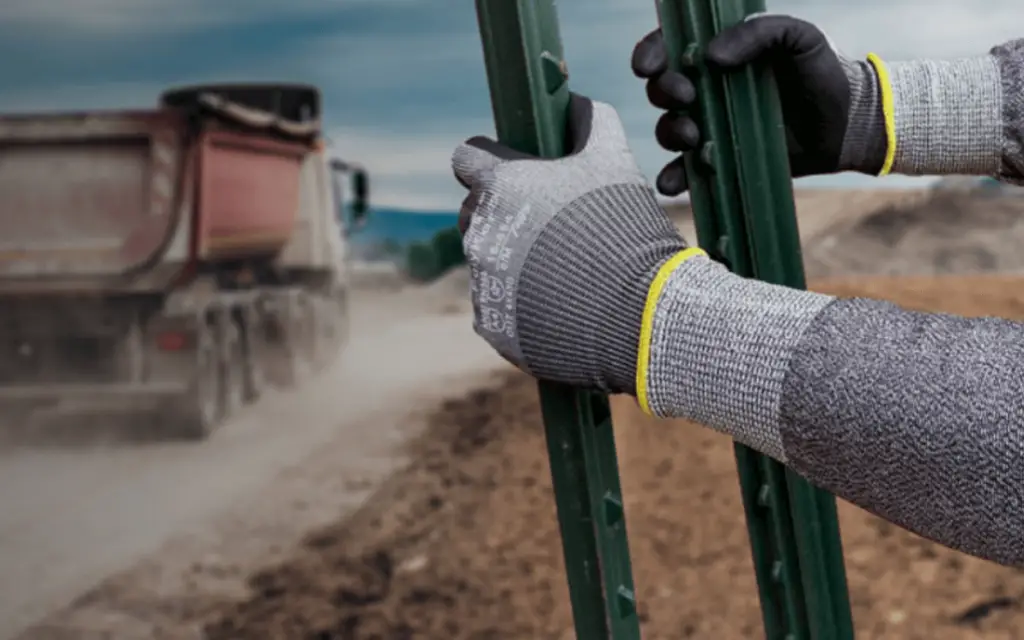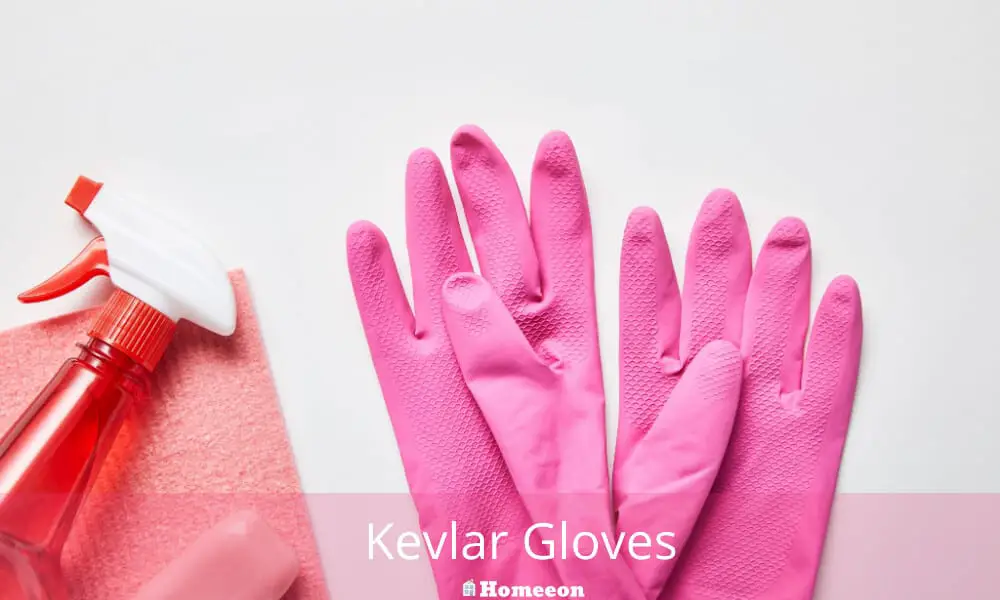Last Updated on August 14, 2023 By Emma W. Thomas
Kevlar gloves are used for hand protection in various industries. With exceptional cut and abrasion resistance, they are employed in construction, automotive, manufacturing, and even law enforcement. Kevlar’s strength, up to 5 times that of steel, shields against cuts, punctures, and heat, enhancing workplace safety.
What Are Kevlar Gloves Used For?
Kevlar gloves are specialized hand protection gear made from Kevlar, a strong and heat-resistant synthetic fiber. They find applications in a wide range of industries due to their exceptional properties. Here’s a detailed look at how Kevlar gloves are used:
- Cut and Puncture Protection: Kevlar is known for its high tensile strength, making Kevlar gloves effective in providing protection against cuts and punctures. Industries such as manufacturing, automotive, glass handling, and metalworking use Kevlar gloves to safeguard workers from sharp edges, blades, and other potential hazards.
- Construction and Carpentry: Construction workers, carpenters, and masons often use Kevlar gloves to protect their hands from sharp tools, nails, and rough materials. The gloves help prevent injuries and abrasions while maintaining dexterity.
- Industrial Applications: Kevlar gloves are used in various industrial settings where workers are exposed to machinery, equipment, and materials that pose a risk of hand injuries. This includes tasks involving handling of metal sheets, machinery maintenance, and operating heavy equipment.
- Manufacturing: In manufacturing industries, Kevlar gloves are employed during tasks that involve the assembly and handling of products with sharp edges, such as electronics, plastics, and metal components.
- Law Enforcement and Security: Law enforcement officers and security personnel often wear Kevlar gloves for protection against sharp objects and potential hand injuries when handling suspects, conducting searches, or dealing with hazardous materials.
- Glass and Ceramics Industry: Workers in the glass and ceramics industry use Kevlar gloves to handle fragile and sharp-edged products, minimizing the risk of cuts and punctures while maintaining grip and dexterity.
- Food Processing: Kevlar gloves are used in the food processing industry to provide protection while handling knives and other cutting tools, reducing the risk of injuries among workers.
- Heat Resistance: Kevlar gloves offer good heat resistance, making them suitable for tasks that involve exposure to high temperatures, such as welding and working with hot materials.
- Aerospace and Aviation: Workers in the aerospace and aviation industries use Kevlar gloves during various tasks, such as handling composite materials, which can have sharp edges.
- Emergency Services: Firefighters and emergency responders use Kevlar gloves for their cut and heat-resistant properties. These gloves can protect hands from sharp debris and offer a layer of defense against heat and flames.
Advantages and Disadvantages of Kevlar Gloves
| Advantages of Kevlar Gloves | Disadvantages of Kevlar Gloves |
|---|---|
| Excellent Cut and Puncture Resistance | Limited Chemical Resistance |
| High Tensile Strength | May Be Less Comfortable Than Other Materials |
| Heat Resistance | Relatively Expensive |
| Dexterity and Flexibility | Not Suitable for All Environments |
| Lightweight and Breathable | May Not Provide Sufficient Grip |
| Durability and Longevity | Limited Protection Against Chemicals and Solvents |
| Versatile for Various Industries | May Not Protect Against All Hazards |
| Minimal Lint and Fiber Shedding | May Require Special Handling and Care |
Can Kevlar Gloves Stop A Bullet?

Kevlar is known for its antiballistic properties. It is a synthetic fiber constructed from chained-together molecules similar to those found in reinforced concrete. This material is commonly used to make knife-proof body armor and bulletproof vests. A lot of energy is used to break through the fiber with knives and bullets.
Kevlar is tightly woven, and it dissipates and soaks up energy, so even if the fibers are forced apart, the force slows down, leading to less damage. Kevlar is ideal for safety gloves used where cut, and puncture resistance is needed such as metal-assembly and engineering works. A perfect example is Polyco Reflex KN plus gloves with a high EN 388 European Standard testing score for mechanical hazards. This glove also provides the user with great flexibility, and it is sensitive to the touch.
Qualities Of Kevlar Gloves
Besides being antiballistic, Kevlar gloves have other attributes that make them perfect as protective gear. These include;
1. Heat Resistance
When working in hot environments such as glass and metal forming, you require heat-resistant gloves to remain safe and productive. Kevlar gloves offer excellent performance necessary for workers who are exposed to hot surfaces and objects. Unlike most plastic, this fabric does not support combustion, burn, or melt.
Kevlar fiber is inherently flame-resistant and does not decompose at temperatures below 450oC, higher than in most working environments. Gloves such as Polyco Ingot Heat-beater can withstand temperatures of up to 500oC for 62 seconds and are thus suitable for use in glass manufacturing and foundry work.
2. Lightweight
Kevlar is thinner and lighter than most traditional equivalents making its gloves perfect for heavy-duty applications such as welding. It is also beneficial for application in areas such as food preparation and gardening. These gloves are lightweight and form-fitting, and therefore, give the use of the utmost skill that is vital in tasks like cutting vegetables on a mandolin.
Looking for a good quality Kevlar glove? Here is one that we recommend:
[amazon box=”B01DUZZP9W” price=”none”]Are Kevlar gloves Cut Resistant?
Kevlar fiber, used in Kevlar gloves’ construction, is an incredibly dynamic, lightweight, and rugged material. The material resists heat, flame, and cut. Kevlar gloves are ideal for a variety of high-performance and demanding professional activities. They can be used for tactical & police works, and recreational activities such as bike riding, or oyster shucking.
The cut-resistant gloves protect the user against hand and finger injuries while on the job.
What Is The Use Of Cut-Resistant Gloves?
Cut-resistant gloves protect the user against sharp objects such as knives, but they provide little protection from puncture injuries. Although there may be a loss of skill when using the gloves, the user is safe from the cut by sharp objects.
These gloves are suitable when handling ceramic, metal sheets, tubing, or glass sheet with sharp edges, or machined parts with sharp edges. You can also use these cut-resistant gloves when using razor blades, hand saws, knives, etc. However, it is necessary to note that cut-resistant gloves cannot be used as protection against powered blades such as drills, mills, or saws.
Using this gear close to powered equipment can lead to severe injuries if caught in moving the required protection level. You may not get the necessary protection while using the gloves since they are rated for little puncture protection.
Safety Precautions When Using Kevlar Gloves
Ensure that you inspect your gloves before using them for possible tears, weak areas, or holes. If necessary, clean these tools every time after use and store them so that they will dry inside and outside. You can wash these items with water and soap but ensure that you follow the manufacturer’s instructions.
The durability of Kevlar gloves depends on how frequently you use them, the conditions of cleaning and storage, as well as the kind of use. Ensure that you dispose of the used gloves as ordinary trash unless contaminated with hazardous material.
What Is Level 5 Cut-Resistant Gloves?
A level 5 cut-resistant glove is one that can endure at least 7.7 pounds or 3,500 grams on the blade without the material getting cut through. EN 388 is also another standard glove that uses a rotating circulating blade instead of a straight razor.
What Is A Cut Level?
Different standards are applied in determining the hardness of glove material to cut through or its resistance to cutting. These standards use a five-level scale to rate cut-resistance, but they end up with the same results.
How To Choose The Right Cut-Level A Task
Some jobs may have specific cut-level requirements stated, but it is essential to know the protection offered by different gloves. The following information is worth looking at;
1. Cut Level 1
Cut level 1 gloves are used on shallow cut hazard areas, and they protect your hands from light scratches and paper cuts but not against real blades. The items are ideal for jobs that do not involve sharp objects like landscaping or car maintenance work.
2. Cut Level 2
These types of gloves are used in low-cut hazard jobs. This level of protection is suitable for automotive assembly, construction work, or packaging projects.
3. Cut Level 3
Ideal for moderate hazard jobs, this level of gloves protects metal stamping and glass handling jobs.
4. Cut Level 4
These gloves are suitable for high-cut hazards such as most metal stamping and glass handling jobs and food service.
5. Cut Level 5
Cut-level 5 gloves are perfect for use in extreme cut-hazard jobs that involve exceptionally sharp blades. They are suitable for use in meat butchery, plate glass, or heavy metal stamping work.

Final Word
Kevlar gloves are protective gear used to protect workers from cut, abrasion, or burns. Ensure that you choose the right tools for your job and follow the manufacturer’s instructions to use, clean, and maintain.
References:
https://logoworkgloves.com/blog/impressive-protection-the-benefits-of-kevlar-gloves/
https://www.safeopedia.com/definition/933/kevlar-gloves
Emma is a graduate of Domestic Science or Family and Consumer Sciences (Home Economics) from the University of Wisconsin. She has 7 years of experience Working with the strategic section of BestBuy and now writing full-time for Homeeon.
From Managing the Home, Interiors, Cleaning, and Exteriors to Gardening and everything about Making A Home Liveable – is her passion and this Homeeon is the result of this.
Emma loves decorating her home with the best stuff found online. She cares about quality over anything and writes reviews about them here in Homeeon. Get in touch with her over Pinterest.
Keep reading her blogs.

